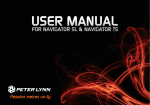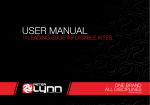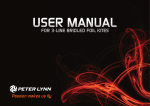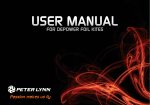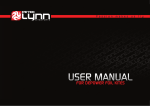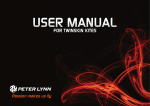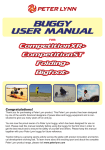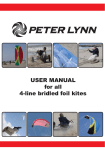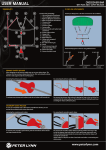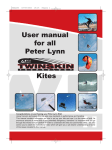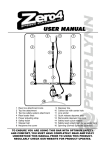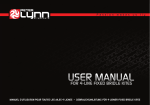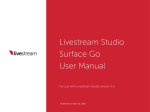Download Magnet manual
Transcript
WELCOME Thank you for buying this Peter Lynn product, and welcome to the World of Peter Lynn, a world of wind driven excitement, where people passionately pursue their dreams whether that’s freeriding at a local beach or enjoying the virgin snow on a back country adventure. Peter Lynn is there to help them pursue their dreams, Peter Lynn is here to help you pursue your dream, making you achieve your ultimate challenge. Are you ready? Peter Lynn has been there taking challenges from the early days of the sport. Challenges to develop breakthrough ideas, make better products, improve performance and quality in all aspects of those products. We have the right kites for all kite disciplines, for any terrain and for all conditions. All this is realized by a passionate crew of kite sports enthusiasts and we invite you to join us. It’s that passion that makes us fly. Before any attempt to use this product, please ensure you pay full and careful attention to the contents of this manual. While traction kiting is an exciting and fun sport, it can be highly dangerous, especially if not all the necessary safety precautions are taken. So please make sure you learn this great sport in a safe way. Only then will you progress quickly and enjoy this beautiful sport to the max. Enjoy! Safety instructions CAUTION: Kite powered sports can be very dangerous and physically demanding. The user of this product should understand that participating in kite powered sports may involve serious injury or death and agrees to observe the safety precautions listed below. Safe location and weather conditions: • Stay away from power lines, roads, airfields, railway lines, trees and buildings. • Never launch your kite in crowded areas. Do not fly your kite over bystanders. • Make sure there is a ‘clear’ downwind area at least three times the distance of your flying line length. • Never fly kites or use this product in thunderstorms, lightning or gusty/stormy winds. • Never fly a kite or use this product with wind forces so strong that you are unable to maintain full control of your kite and its power at all times. • Do not fly a kite or use this product when wind conditions are likely to change dramatically. • Stop kiting immediately when a (thunder)storm is approaching. • Make sure you are familiar with the location and local customs and laws before attempting any kind of kite sports. Safe traction kiting: • A traction kite is not a toy and should not be flown by inexperienced persons and certainly not by children. • Learn to fly kites by starting in light winds with a small sized kite. • Never use any type of kite or this product for paragliding, parachuting or base jumping. • Never use any type of kite or this product for jumping off high places like hills or cliffs • Never use any type of kite or this product for any manlifting activity. • Always wear fully protective gear. Safety issues when using this product: • Prior to every use of this product, fully check your equipment for any signs of wear and tear. Replace parts immediately where needed. • Prior to every use of this product, check if your safety releases are still working properly and you are aware how to use it. In case the safety release does not work as it should, do not use this product and replace parts where needed. • Only use this product for power kiting, buggy riding, landboarding and snowkiting. • Only use this product when you are in a good state of health. Never use this product when under the influence of alcohol, drugs or medication. • Do not alter, modify or change this product. Repairs should be done by a professional kite repair shop, sail repair shop, or by the Peter Lynn company. Terminology 1 2 3 2 1 4 5 5 6 6 7 8 9 10 12 11 Centrix push-away terminology 21. Dual depower line 22. Safety line running through depower loop 23. Swivel 24. Centrix push-away main body with Safety release cuff 25. Safety leash attachment ring 26. Depower loop tube 27. Depower loop lock-in pin 21 22 23 24 13 25 14 15 15 16 Magnet depower bar terminology 1. Rear flying line connector 2. Top flying line connector 3. Life line / safety flying line connector 4. Life line / safety flying line 5. Top flying line 6. Rear flying line 7. Center top flying line 8. Safety line 9. Top pulley of the power adjuster 10. Power adjuster cleat 11. Relaunch handle 12. Left leader line 13. Right leader line 14. Depower / adjuster line 15. Endcap with integrated bungee chord 16. Tapered bar with EVA foam finger grip 17. Centrix depower loop with push-away safety release 18. Depower loop lock-in pin 19. Safety leash 20. Harness attachment with quick release 19 17 26 18 20 27 Primary Safety release When things get out of hand you might want to use your safety release. The Magnet control bar has a primary release on the depower loop. After activating the release, the kite is only supported by the Life line / safety flying line. Activating the primary quick release Re-connecting the primary safety release To activate your primary quick release, push the red release cuff part towards the kite. Re-connect the primary safety release by placing stainless steel ring on the end of the depower loop tube into the Centrix push-away center piece until it locks in behind the hook inside the center piece. Now slide the release cuff towards the spreader bar. Always make sure all parts are free of sand and snow before re-connecting your safety system. Secondary quick release In case you completely want to disconnect yourself from the kite, you can activate the secondary quick release afterwards. Activating the secondary quick release Re-connecting the secondary quick release To activate your secondary quick release, move the red release in the direction of the arrows. Re-connect the secondary safety release by placing the loop over the stainless steel pin, folding the pin down an sliding the relaese cuff back in place. Make sure the release cuff is sitting right against the ball after reconnecting. setting up your leash There are two different methods of setting up your leash. Standard setup - When pulling the safety release or when letting go of the bar while being unhooked, the kite will lose its shape and slowly move towards the ground. ‘Suicide leash’ setup - When pulling the safety release the kite will lose its shape and slowly move towards the ground. When letting go of the bar while being unhooked, the kite will keep its shape and the bar will stay closer to the rider, for a faster recovery. CAUTION! The ‘suicide leash’ setup is for expert riders only! Use it at your own risk. Do not use a ‘suicide leash’ in unpredictable wind conditions or when riding overpowered. Standard safety leash setup ‘Suicide leash’ safety setup Attach the safety leash to the round attachment ring on the end of the red safety line. Attach the safety leash to the round attachment ring on the end of the red safety line. Attach the triangle shaped ring of the leash attachment to the rectangle shaped ring on the end of the depower loop tube. Depower loop lock-in pin DEPOWERING / POWERING After hooking in your depower loop, you can use the security pin to prevent your depower loop from accidentally unhooking from your spreader bar. Place the lock-in pin through the spreader bar hook, just below the depower loop tube. Depowering your kite Powering your kite When pushing the bar away, the power When pulling in the bar, the kite will of the kite will be reduced. produce more power. Using the power adjuster To set the overall power of the kite, you can use the power adjuster. To reduce the overall power of the kite, pull in the line coming out of the adjuster cleat. To increase the overall power of the kite, pull the line slightly towards you and move it away from the cleat. Now let the line out and let it lock back into the cleat at the desired position. Swivel Relaunch handle The top section of the Centrix depower loop is fitted with a swivel to unspin your top flying lines. To prevent any wear and tear, as well as any malfunctioning of the safety system, regularly unspin your top flying lines by using the swivel. The relaunch handle can be used to reverse relaunch the kite when it is leading edge down. It may also be used to self-land your kite in light winds. To relaunch your kite with the leading edge down, pull on the relaunch handle to make the kite fly up in reverse. Packing up After finishing your kiting session, you can wind the lines onto the bar ends, using figure of eights. Secure the lines by using the bungee chords. When self-landing in light winds, pull the relaunch handle when the kite is close to the ground. The relaunch handle can be secured to the ground by placing a groundstake through the small loop. Removing depower/adjuster line If your depower/adjuster line is worn it is recommended to replace it. This will ensure maximum safety and rider comfort. Remove the Velcro piece on the end of the adjuster line and remove the ball by undoing the screw and sliding it off. Remove the depower / adjuster line from the clamcleat, the top pulley, the large ring with Velcro and the bar. Undo the two screws on the top section of the Centrix push-away depower loop to disassemble the top section / swivel. Undo the leash attachment ring on the end of the safety line and slide the safety line out of the Centrix pushaway depower loop. Assemble the the parts of the top section / swivel of the Centrix push-away depower loop and secure it with the two screws. Slide the depower /adjuster line through the bar, large ring with Velcro, clamcleat and top pulley. Make sure the clamcleat is placed just below the stitching of the double section. Place the ball onto the adjuster line and secure it next to the double section of the line. Re-attach the Velcro piece on the end of the adjuster line using a larkshead knot. Placing depower line Slide the safety line through the small depower line attachment piece and the main body of the Centrix pushaway depower loop. Use a larkshead to attach the safety leash attachment ring to the safety line. Care and maintenance Peter Lynn products are designed to be strong and durable. The extreme nature of kite sports puts a high strain on the equipment involved. By taking good care of your equipment, you can minimize the wear on your equipment. • Make sure you regularly check your bar for wear and tear. Make sure to check your depower loop, depower loop tube, depower/adjuster line, adjuster, safety line, endcaps, flying lines and sleeves on the flying lines. Replace parts when needed. There should be a large amount of replacement parts available at your local dealer. • Before launching, always check that your quick release is in working order and free of sand or other debris. • Make sure your flying lines are free of knots. • After launching, wipe as much sand or snow off your bar as possible. Especially remove sand or snow from the depower loop, depower/adjuster line, center hole in your bar, stopper and adjuster. Also get rid of any sand or snow on the safety line on the section next to the depower line. • After every session, rinse your bar with tap water to remove the salt from the bar. Make sure your depower loop, depower/adjuster line, stopper and adjuster are free of sand. If there are problems with your bar, please contact your Peter Lynn dealer. Warranty Peter Lynn warrants this product, when it is purchased from an authorized Peter Lynn dealer by a retail customer, to be free of major defects in material or workmanship to the original purchaser, for a period of six (6) months from the date of purchase by the original retail customer. This warranty is subject to the following limitations: • The warranty is solely for the benefit of the original retail purchaser and may not be assigned. For retail customer warranty claims, proof of purchase from an authorized Peter Lynn dealer is required. If the date of purchase can not be established, Peter Lynn will make a determination based on the last production year and/or the condition of the particular product claimed. • The warranty on this product is valid only when it is solely used for designated purposes and does not apply to any product used for rental and/or teaching purposes. • Peter Lynn will make the final warranty determination, which may require inspection and/or photos of the equipment. Photos must clearly show the defect(s). If necessary, this information must be sent to the Peter Lynn dealer where the product was originally purchased, postage prepaid. Alternatively you may contact the Peter Lynn distributor in (or nearest to) your country. • If a product is deemed to be defective by Peter Lynn, the warranty covers the repair or replacement of the defective product only. Peter Lynn will not be responsible for any costs, losses, or damages incurred as a result of loss of use of this product. This warranty does not cover damage caused by misuse, abuse, neglect or normal wear and tear including, but not limited to, damage due to excessive sun exposure, use in combination with other than Peter Lynn control gear, damage caused by improper handling and storage, and damage caused by anything other than defects in material and workmanship. • The warranty is voided if any unauthorized repair, change or modification has been made to any part of the equipment. The warranty for any repaired or replaced equipment takes effect from the date of the original purchase only. The original purchase receipt must accompany all warranty claims. The name of the Peter Lynn dealer and the date of purchase must be clear and legible. • There are no warranties which extend beyond the warranty specified herein. Warranty Claims Warranty claims must be processed through an authorized Peter Lynn dealer and be issued a return authorization prior to shipping the product concerned. For claims processing please contact the Peter Lynn dealer the product was purchased from or call - or write to - the national Peter Lynn distributor. If there is no Peter Lynn distributor in your country, please find our contact details on our website www.peterlynn.com. DISCLAIMER – RELEASE OF LIABILITY Peter Lynn / Vliegerop bv. - Release of Liability Caution Before making any attempt to set up or use this product, you agree to have read and fully understood the entire Peter Lynn user manual; including, but not limited to, all instructions and warnings it contains. You also agree to make sure that any other user of this Peter Lynn product, prior to using it, will also read and fully understand this Peter Lynn user manual; including, but not limited to, all instructions and warnings it contains. Assumption and acceptance of risk Kite powered sports can be very dangerous and physically demanding. While powerkiting in its many forms is an exciting and fun sport, it can be highly dangerous for yourself and others around you, especially if the necessary safety precautions are not or only partly taken. The user of this Peter Lynn product should understand that participating in kite powered sports can result in serious personal injury – and even death – to the user as well as to third parties. Before setting up and using this Peter Lynn product you agree to assume and accept any risk of injury, whether known or unknown, to both yourself and any third parties from using this Peter Lynn product. To reduce these risks, we strongly recommend you to stick to the safety precautions listed in this Peter Lynn user manual. Disclaimer and Release of Liability Concerning the purchase of this Peter Lynn product by you, you hereby agree, to the greatest extent allowed by law, to waive any claims you have or may have in the future against Peter Lynn and all related entities resulting from using this Peter Lynn product and/or any of its components. You will also release Peter Lynn and all related entities from any liability for special, indirect, incidental, consequential or exemplary damages, whether in contract, tort, negligence, strict liability or otherwise including, but not limited to, loss of property other than this Peter Lynn product, loss of use of this product, or other property or other economic losses. Peter Lynn shall not be liable for contribution or indemnification, whatever the cause. All terms and conditions contained herein shall, in the event of your death or incapacity, apply and be binding upon your heirs, next of kin and any other representatives including, but not limited to, administrators and executors. The foregoing provisions regarding liability and warranty are exclusive and in lieu of all other liability- and warranty statements, whether written, oral or implied.












